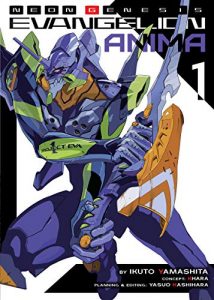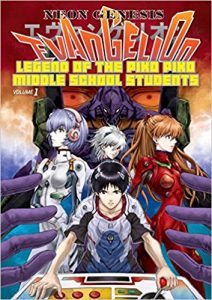By Ikuto Yamashita. Released in Japan as “Shin Seiki Evangelion Anima” by Kadokawa Shoten, serialized in the magazine Dengeki Hobby. Released in North America by Seven Seas. Translated by Michael Rachmat. Adapted by Peter Adrian Behravesh.
And so the light novel series that was written for a magazine dedicated to the selling of plastic models and toys ends the only way that it honestly could: with 250 more pages that show off just how great these Eva battles would look if you put the models together. If you love looking at Evas and imagining them fighting each other, it’s a terrific book. If you do not – and I am counting myself here – it’s a letdown. My expectations were not all that high… indeed, they mostly just involved hoping that we were done with thousands of people turning to salt. (I was wrong, alas.) And there are actual plot and character moments here. But the character moments aren’t enough, the plot is sometimes bad, and the ending merely stops, when it cries out for an epilogue of some sort. Sorry, kids, who knows what happens next, but it will be in a world where giant robots don’t fight, so who cares?
We pick up right where we left off, as everyone’s trying to figure out a way to save the day despite Shinji having .83 seconds to go till Third Impact. Mari is desperately searching for a pack of SOME sort, even if it’s not her original, and does not really give two figs about anyone else. Hikari is possessed by evil. Kaji, also possessed by evil, is being smug in Misato’s direction. The Reis are finally sharing minds again, but that may not be a good thing. The only sensible ones seem to be Asuka and Toji, and unfortunately both of them lose their sense of self as the book goes on. How many apocalypses can Earth go through before it finally gives up the ghost? Can Shinji stop it all? And will we get the weirdest Biblical imagery ever?
The best parts of the book were when it was so over the top I had to laugh out loud. Kensuke and (a now unposessed) Hikari manage to survive certain death by hiding under the Shroud of Turin, a line tossed off so casually it’s brilliant. The way that Shinji, now dead, ends up coming back is so grotesque and awful that my jaw dropped, and to be fair Asuka thinks the exact same thing I did: ew. At the same time, the reappearance of some seemingly dead characters right at the end, and reaction to same, falls absolutely flat, mostly as everything is too chaotic to stay on them for even a moment. Likewise, two characters no longer being evil is barely even given weight because, as I said, apocalypse uber alles. The book keeps such a frenetic pace throughout that you can’t enjoy anything, and then when armageddon is finally avoided (somewhat), it simply stops. The end.
That said, I hear the movies weren’t really satisfying to some viewers either, and the manga (probably my favorite version) also had its issues. Evangelion may simply be too messy a story to have a decent ending for. And these books did have some pretty cool fights. If you want another version of what happens, and aren’t really invested in any one character, this is a series to read. Sadly, my overall reaction to the series ends up being a shrug.





